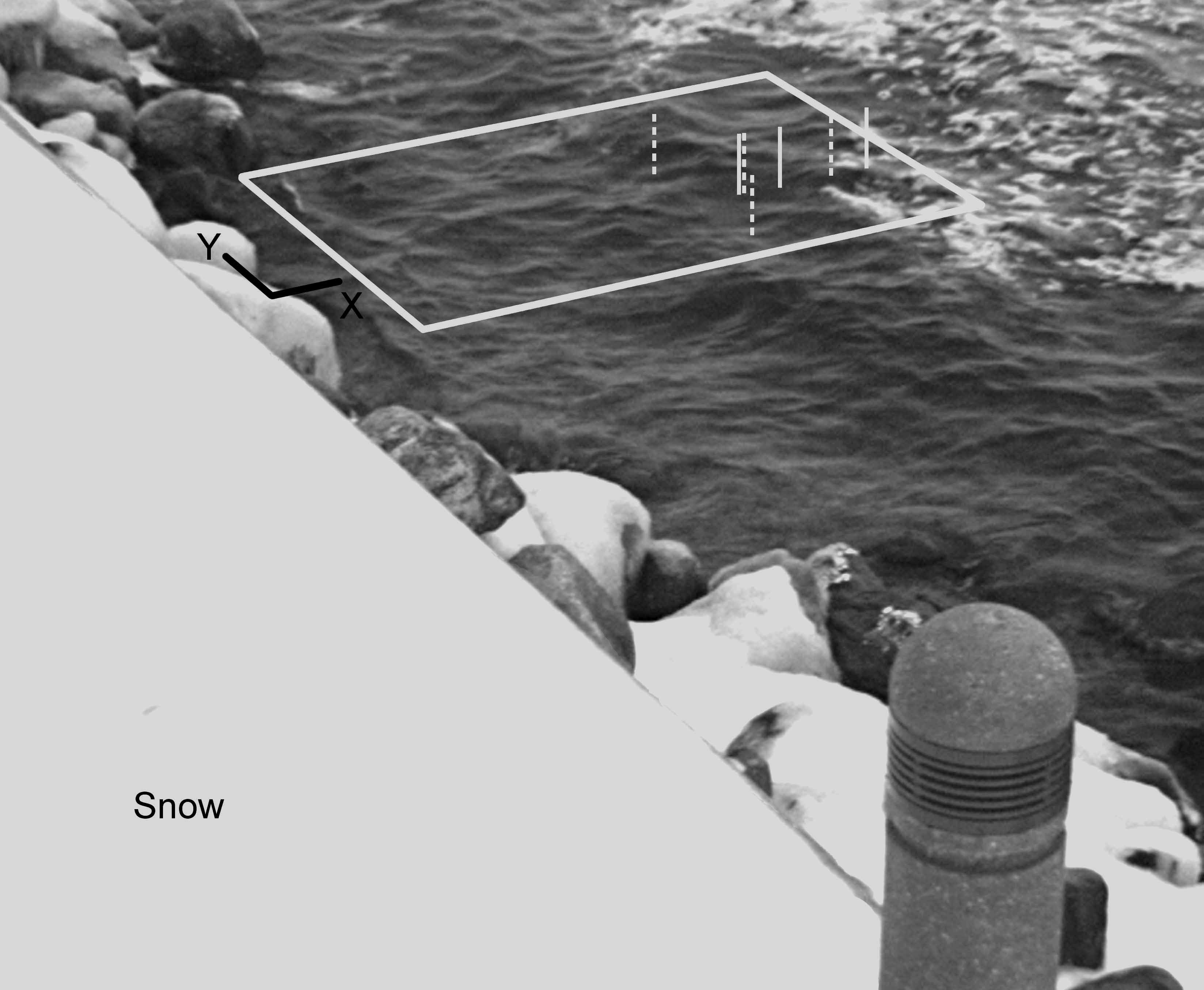

freak wave on a 10 cm/s following current freak wave on a 10 cm/s opposing current
To capture freak waves, we have been developing a novel Automated Trinocular Stereo Imaging System (ATSIS), a non-intrusive remote sensing technique, to measure temporal evolution of three-dimensional wave characteristics. The system consists of three progressive digital cameras to accurately estimate depth of a scene. In addition the advantage of using extra camera resolves the correspondence problems due to specular reflection on the water surface and provides additional constraints on image matching, dramatically reducing the chance of a mismatch. An oblique configuration for the trinocular system effectively increases spatial coverage, allowing observations of wave phenomena over a broad range of spatial scales. A new exterior calibration procedure is also developed to determine the orientation of cameras in the field. The height resolution is increased with the optical axes of the cameras pointed at an oblique angle with respect to vertical surface wave displacements.

Stereo-imaging of a 3D breaking wave 3D view of the processed image Virtual wave gauge array
Furthermore. we also developing the-state-of-the art models for depict freak wave motions. For several decades, a great deal of efforts has been paid to develop unified models that can effectively predict water wave propagation with varying degree of dispersive and nonlinear effects. Our research group is focusing on develop an efficient and accurate non-hydrostatic modeling frame to predict large scale surface wave dynamics. Overall the goal is to develop full non-hydrostatic model using a small number of vertical layers (two ~ five layers) to simulate nearshore wave transformation including shoaling, dispersion, refraction, and diffraction phenomena. Furthermore we are also working on developing a non-hydrostatic model that can examine deep-water wave-wave interactions including slowly modulated and rapidly evolving wave processes leading to the formation of freak waves.

 Shoaling and
diffraction
Refraction and
diffraction
Frequency dispersion focusing
Shoaling and
diffraction
Refraction and
diffraction
Frequency dispersion focusing Media
- Lake
Superior Rogue Waves, Medium.com, Feb.2017
- With
Edmund Fitzgerald in mind, scientists confirm rogue
waves on Lake Superior, TwinCities.com Pioneer Press,
Dec. 2015.
- The Three Sisters, Wilderness North, Dec. 2015
- Did
Rogue Waves Sink Edmund Fitzgerald? Lake Scientist,
Nov. 2015
- Scientists
confirm rogue waves on Lake Superior,, MinnPost, Nov.
2015
- Did a freak wave sink the Edmund Fitzgerald? UW-Madison, Nov. 2015
- Scientists
confirm Lake Superior rogue waves, Duluth News
Tribune, Nov. 2015.
- Wisconsin
Researchers Study “Rogue Waves” Like Ones Thought to
Have Sunk the Fitzgerald, UW-Sea Grant, Nov. 2015
- UW scientist study killer waves in Lake Superior, The Badger Herald, Nov. 2015
- AquaLog:
35th Anniversary of Sinking of Edmund Fitzgerald, Nov.
2010.
- The Real Sea Monsters: On the Hunt for Rogue Waves, Scientific America, Sept. 2009.
- Rogue
Waves and Explorations of Coastal Wave
Characteristics, NOAA-GLERL, 2002
Publications
- Characteristics and Occurrence of Freak Waves in the
Apostle Islands, Lake Superior, Submitted 2019.
- Anderson, J.D. and Wu, C.H., Development and Application of a real-time water environment cyber-infrastructure for kayaker safety in the Apostle Islands, Lake Superior, Lake Superior. J. of Great Lakes Research, 44(5), 990-1001, doi.org/10.1016/j.jglr.2018.07.006, 2018
- Anderson, J.D., Wu, C.H., and Schwab, D.J., Wave
climatology in the Apostle Islands, Lake Superior, J.
Geophysical Research-Oceans, 120(7), 4869-4890,
2015.
- Liu, P.C., Wu, C.H., Bechle, A.J., MacHutchon, K.R., and Chen, H.S., What do we know about freaque waves in the ocean and lakes and how do we know it, Natural Hazards and Earth System Sciences, 10, 2191-2196, 2010.
- Young C.C. and Wu, C.H., A σ - coordinate
non-hydrostatic model with embedded Boussinesq-type like
equations for modeling deep-water waves, International
J. for Numerical Methods in Fluids,
63(12),1448-1470, 2010.
- Young, C.C. and Wu, C.H., Non-hydrostatic modeling of nonlinear deep-water wave groups, J. of Engineering Mechanics-ASCE, 136(2), 155-167, 2010.
- Young, C.C. and Wu, C.H., An efficient and accurate non-hydrostatic model with embedded Boussinesq-type like equations for surface wave modeling, International J. for Numerical Methods in Fluids, 60(1), 27-53, 2009.
- Yao, A. and Wu, C.H., Spatial and temporal characteristics of transient extreme waves on depth-varying currents, J. of Engineering Mechanics-ASCE, 132 (9), 1015-1025, 2006.
- Yao, A. and Wu, C.H., Incipient breaking of unsteady waves on sheared currents, Physics of Fluids, 17, 082104, 2005.
- Wu, C.H. and Yao, A., Laboratory measurements of limiting freak waves on currents, J. Geophysical Research-Oceans, 109, C12, C12002, 1-18, 10.1029/2004JC002612, 2004.
- Yao, A. and Wu, C.H., Energy dissipation of unsteady wave breaking on currents, J. Physical Oceanography, 34, N10, 2288-2304, 2004.
- Wu, C.H. and Nepf, H. M, Breaking wave criteria and energy losses for three-dimensional breaking waves, C10, 3177, 10.1029 2001JC001077, 41-1-18, J. Geophysical Research-Oceans, 2002
Cyber-infrastructure Tools
- Sea Caves Watch (Real Time Wave Observation System)
- Safety index for kayaks in Sea Caves
- Water Information for a Safe Coast (WISC-Watch)
- INFOS - Apostle Islands for waves and circulations